Comments / Questions (107)
![]() Nina wrote:
Nina wrote:
Dehnt sich das Strickstück nach dem waschen sehr doll? Ich stricke gerade Größe L wie angegeben, aber der Kragen wirkt etwas eng und die angebende Länge scheint auch etwas kurz.
11.10.2025 - 14:17DROPS Design answered:
Liebe Nina, wenn Sie die Maschenprobe eingehalten haben, sollte der Halsausschnitt wie in der Maßskizze gezeigt werden. Das Muster des Pullovers ist an sich sehr elastisch. Sie können den Pulli aber auch in Form ziehen, wenn er nach dem Waschen noch feucht ist. Was die Länge betrifft, können Sie ihn auch einfach etwas länger stricken.
22.10.2025 - 00:31
![]() FRANCOISE wrote:
FRANCOISE wrote:
Bonjour J'ai encore une question. Comment tricote-t-on les 9x2 nouvelles mailles sur le dos/devant. Faut-il démarrer par le tour 1 puis le tour 3 puisque nous sommes au tour 3 pour le reste du tour. Ou un rang envers puis le tour 1 et 2 et 3. Merci
09.10.2025 - 21:14DROPS Design answered:
Bonjour Françoise, vous pensez au 1er tour du dos/devant, après la division de l'empiècement? Ces mailles se tricotent comme les autres, les côtes anglaises doivent maintenant tomber juste tout le tour, comme vous avez divisé l'ouvrage en tricotant un tour 3 des côtes anglaises, le 1er rang du bas du pull sera un tour 2, mais comme vous n'avez pas de jeté ni de mailles glissées dans les nouvelles, mailles, tricotez les mailles à l'envers, seules. Bon tricot!
10.10.2025 - 08:09
![]() FRANCOISE wrote:
FRANCOISE wrote:
Bonjour Y a t-il toujours 7 mailles entre les deux augmentations du raglan ? Faut il faire chaque augmentation du raglan 4 mailles avant le curseur ? Merci pour votre aide
22.09.2025 - 16:23DROPS Design answered:
Bonjour Françoise, tout à fait, vous devez avoir 7 mailles côtes anglaises entre les augmentations; vous allez ainsi augmenter 2 mailles dans une maille, puis tricoter les 7 mailles du raglan en côtes anglaises et vous augmentez 2 mailles dans la maille suivante. Vous allez ainsi augmenter à chaque fois 4 mailles pour le devant/le dos / les manche (2 au début + 2 à la fin). Bon tricot!
24.09.2025 - 08:13
![]() FRANCOISE wrote:
FRANCOISE wrote:
Bonjour Il est précisé que l'augmentation du raglan se fait uniquement sur le tour 2 c'est à dire en tricotant à l'envers. Or l'augmentation se tricote à l'endroit. Est ce normal ? Pour le tour suivant, comment dois-je tricoter les mailles augmentées. A l'envers ou à l'endroit. Merci
07.09.2025 - 17:38DROPS Design answered:
Bonjour Françoise, les augmentations se font sur un tour 2 des côtes anglaises, lorsque l'on doit tricoter la maille envers et son jeté ensemble à l'envers, on va augmenter comme dans cette vidéo (pour un autre modèle, mais vous verrez au time code 1:10 environ comment augmenter et comment les tricoter ensuite au tour suivant. Bon tricot!
08.09.2025 - 10:57
![]() FRANCOISE wrote:
FRANCOISE wrote:
Bonjour Auriez vous une video pour expliquer l'augmentation du raglan en côte anglaise ? Merci
25.08.2025 - 17:35DROPS Design answered:
Bonjour Françoise, vous pourrez retrouver dans cette vidéo (pour un autre modèle/un autre nombre de mailles) comment augmenter (time code 1:04 environ) et comment tricoter les mailles au tour suivant (4:14 environ). Bon tricot!
26.08.2025 - 15:40
![]() FRANCOISE wrote:
FRANCOISE wrote:
Petite précision Si j additionne 13+13+27+13+14 j’obtiens 80 alors que j’ai 84 mailles sur mon aiguille circulaire Merci Françoise
24.08.2025 - 15:11DROPS Design answered:
Bonjour Françoise, notez bien que les marqueurs sont ajoutés dans une maille, d'où les 4 mailles manquantes de votre décompte, vous aurez: 13+1+13+1+27+1+13+1+14=84. Bon tricot!
25.08.2025 - 09:36
![]() FRANCOISE wrote:
FRANCOISE wrote:
Bonjour Comment dois je compter les mailles (côtes anglaises avec jetés) sur l’aiguille circulaire. Dois je tenir compte des jetés Je ne comprends ce que veut dire « ils doivent être tous être dans une maille envers » Est ce avant ou après ? Merci beaucoup Françoise
24.08.2025 - 13:59DROPS Design answered:
Bonjour Françoise, les jetés ne comptent pas comme des mailles, ils appartiennent à la maille glissée et donc cette maille glissée + le jeté = 1 maille. Les marqueurs doivent être placés dans une maille (et pas entre les mailles), ils seront tous dans une maille envers des côtes anglaises au 1er tour, ces mailles avec un marqueur sera toujours une maille envers des côtes anglaises. Bon tricot!
25.08.2025 - 09:35
![]() Anna Maria wrote:
Anna Maria wrote:
Buongiorno, invece della maglia inglese, eseguo maglia rasata, cambiano le misure? Troppo difficile, maglia a coste inglesi, se cade un punto..complesso recuperarlo , grazie
13.08.2025 - 08:19
![]() Daniel wrote:
Daniel wrote:
Hej När jag ska göra första ökningen i raglan så blir det fel. I beskrivningen står det att jag ska göra första ökningen genom att sticka fjärde maskan före markören (avig + omslag) rät två gånger i samma maska. Men den fjärde maskan består ju endast av en avig maska utan omslag. På andra varvet med helpatent alltså ”varv 3”) så ligger ju alltid de aviga maskorna med omslag på udda maskantal. Vad är det jag inte förstår?
13.07.2025 - 07:57DROPS Design answered:
Hei Daniel. Hvilken str. strikker du? Når jeg tester ut str. S stemmer det. Har du strikket til det gjenstår 4 masker før masken med merket (masken med merket blir da 5. maske fra pinnen)? mvh DROPS Design
31.07.2025 - 11:55
![]() Gadesaude wrote:
Gadesaude wrote:
Je ne comprends pas cette grande différence de taille entre la taille M et le L 18 cm. alors qu'entre le S et le M il ya que 8cm. ainsi qu'entre le L et le XL. Merci pour votre éclairage.
16.06.2025 - 20:36DROPS Design answered:
Bonjour Mme Gadesaude, ce sont les mesures finales correspondant à chacune des tailles, telle que la styliste a écrit le modèle, choisissez la taille qui convient en fonction des mesures finales souhaitées. Bon tricot!
17.06.2025 - 09:18
Lagoon#lagoonsweater |
|
 |
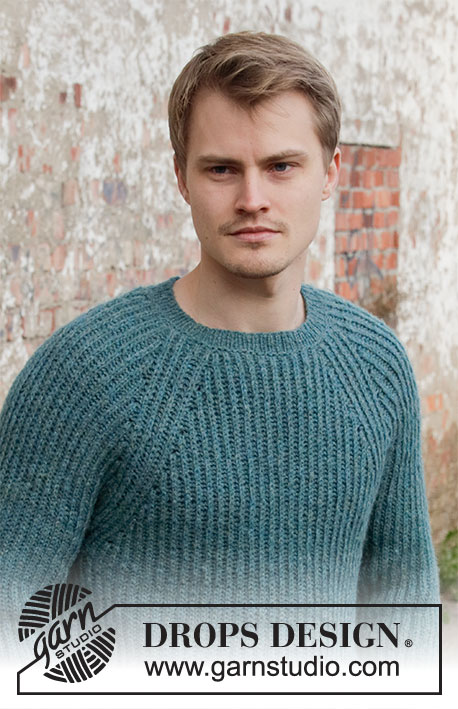 |
Knitted jumper with raglan for men in DROPS Sky. Piece is knitted top down with English rib. Size: S - XXXL
DROPS 208-9 |
|
|
---------------------------------------------------------- EXPLANATION FOR THE PATTERN: ---------------------------------------------------------- ENGLISH RIB: ROUND 1: * Knit 1, 1 yarn over, slip 1 stitch as if to purl *, work from *-*. ROUND 2: * 1 yarn over, slip 1 stitch purlwise, purl together yarn over and slipped stitch *, work from *-*. 3.ROUND: * Knit together yarn over and slipped stitch, 1 yarn over, slip 1 stitch as if to purl *, repeat from *-*. Repeat rounds 2 to 3. RAGLAN: All increases are done on 2 round in English rib pattern! NOTE! If the knitting tension is not correct vertically the raglan increase will be too short/long vertically. Raglan increase is written in both number of round and cm. If the knitting tension is incorrect vertically, work raglan increase in cm. Increase as follows: Work until 4 stitches remain before stitch with marker. Increase 2 stitches in next stitch (one purl stitch + yarn over) as follows: Knit yarn over and stitch together but wait to slip stitch and yarn over off the needle, make 1 yarn over on right needle, knit stitch and yarn over together 1 more time = 3 stitches (= 2 stitches increased). Work the next 7 stitches in English rib as before. Increase 2 stitches in next stitch (one purl stitch + yarn over) as follows: Knit yarn over and stitch together but wait to slip stitch and yarn over off the needle, make 1 yarn over on right needle, knit stitch and yarn over together 1 more time = 3 stitches (= 2 stitches increased). Repeat at each of the remaining markers (= 16 stitches increased in total on round). On next round work the increased stitches in English rib pattern - there are no English rib yarn overs in increase, so on next round in English rib pattern work stitch to be worked together yarn over, without yarn over. DECREASE TIP-1 (evenly): To calculate how to decrease evenly, use the total number of stitches on row (e.g. 96 stitches) and divide stitches by number of decreases to be done (e.g. 16) = 6. In this example decrease by knitting every 5th and 6th stitch together. DECREASE TIP-2 (applies to sleeves): All decreases are done on 2 round in English rib pattern. Decrease as follows: Work like this until 2 stitches remain before stitch with marker slip the next 3 stitches (+ yarn overs that belongs to stitches) loosely over on to right needle as if to knit together, knit the next 2 stitches (+ yarn over that belongs to stitch) together, pass the 3 slipped stitches over stitches knitted together (= 4 stitches decreased). NOTE! On next round do not work any English rib stitch together with middle stitch under sleeve, then on next round in English rib pattern, work stitch together with yarn over, without yarn over. INCREASE TIP (evenly): To calculate how to increase evenly, use the total number of stitches on row (e.g. 164 stitches) and divide stitches by number of increases to be done (e.g. 70) = 2.3. In this example increase by making 1 yarn over after approx. every other stitch. On next round work yarn overs twisted to avoid holes. CAST-OFF TIP: To avoid a tight cast-off edge you may use a needle ½ size larger or cast off with knit over knit and purl over purl and make 1 yarn over after every 4th stitch (cast off yarn overs as regular stitches). ---------------------------------------------------------- START THE PIECE HERE: ---------------------------------------------------------- JUMPER - SHORT OVERVIEW OF THE PIECE: Worked in the round on circular needle, top down. Work sleeves in the round on a short circular needle/double pointed needles. NECK EDGE: Cast on 96-102-106-110-114-118 stitches on a short circular needle size 3 mm with Sky. Knit 1 round, then work rib = knit 1/purl 1 for 4 cm. Knit 1 round while decreasing 16-18-18-22-22-26 stitches evenly - read DECREASE TIP-1 (evenly) = 80-84-88-88-92-92 stitches. Purl 1 round. Insert a marker here (= beginning of round approx. mid back). NOW MEASURE PIECE FROM HERE! YOKE: Switch to circular needle size 4.5 mm. Then work ENGLISH RIB - read explanation above. When 1 round has been worked with English rib, insert 4 markers in piece without working (insert all markers in a purl stitch): Skip the first 13-13-15-15-15-15 stitches, insert a marker in next stitch (= in transition between half back piece and right sleeve), skip the next 13 stitches, insert a marker in next stitch (= in transition between right sleeve and front piece), skip the next 25-27-29-29-31-31 stitches, insert a marker in next stitch (= in transition between front piece and left sleeve), skip the next 13 stitches, insert a marker in next stitch (= in transition between left sleeve and half back piece), there are now 12-14-14-14-16-16 stitches between last marker and beginning of round. REMEMBER THE KNITTING TENSION! There is now one marker in every transition between body and sleeves. Move the markers upwards when working. Continue in the round with English rib, AT THE SAME TIME on next round (= 2nd round in English rib) begin increase for RAGLAN - read explanation above. Increase like this every 6th round (approx. every 1½ cm), 1-2-4-5-6-8 times in total and every 8th round (approx. every 2 cm) 10 times in all sizes = 256-276-312-328-348-380 stitches. When all increases are done, continue with English rib until piece measures 22-24-26-28-30-32 cm from marker, finish after 2nd round in English rib. Work next round as follows: Work the first 37-39-47-49-53-59 stitches (= approx. half back piece), slip the next 55-59-63-67-67-71 stitches on a stitch holder for sleeve and cast on 9 new stitches on needle (= in the side under sleeve), work the next 73-79-93-97-107-119 stitches (= front piece), insert the next 55-59-63-67-67-71 stitches on a stitch holder for sleeve and cast on 9 new stitches on needle (= in the side under sleeve), work the last 36-40-46-48-54-60 stitches on round (= approx. half back piece). Finish body and sleeves separately. NOW MEASURE PIECE FROM HERE! BODY: There are now 164-176-204-212-232-256 stitches on round. Continue in the round with English rib until piece measures 31 cm from division - adjust to finish after 2nd round in English rib. Switch to circular needle size 3 mm. Work next round as follows: * Knit yarn over and slipped stitch together, purl 1 *, work from *-* the entire round, AT THE SAME TIME increase 60-66-70-72-84-82 stitches - read INCREASE TIP = 224-242-274-284-316-338 stitches. Work rib (knit 1/purl 1) in the round for 5 cm. Cast off - read CAST-OFF TIP. Jumper measures approx. 54-56-58-60-62-64 cm from shoulder and down. SLEEVE: Slip the 55-59-63-67-67-71 stitches from stitch holder in one side of piece back on a short circular needle/double pointed needles size 4.5 mm and pick in addition up 1 stitch in each of the 9 new stitches cast on in the side under sleeve = 64-68-72-76-76-80 stitches. Continue in the round with English rib. When sleeve measures 4 cm – adjust so that next round is 2nd round in English rib, insert a marker in the middle stitch under sleeve (= one knit stitch). On next round, decrease 4 stitches under sleeve - read DECREASE TIP-2. Decrease like this every 10-10-5-5-5-4 cm 4-4-5-6-6-6 times in total = 48-52-52-52-52-56 stitches. When sleeve measures 44-43-41-40-38-38 cm – adjust so that next round is 3rd round in English rib pattern, switch to double pointed needles size 3 mm. In S - M – L work next round as follows: * Knit yarn over and slipped stitch together, knit 1, knit yarn over and slipped stitch together, knit 1, knit yarn over as 1 knit stitch, knit slipped stitch as 1 knit stitch, knit 1 *, work from *-*, 8 stitches have been increased on round = 56-60-60 stitches. In XL - XXL work next round as follows: Knit yarn over as 1 knit stitch, knit slipped stitch as 1 knit stitch, * knit yarn over as 1 knit stitch, knit slipped stitch as 1 knit stitch, knit yarn over and slipped stitch together, knit 1 *, work from *-*, 14 stitches have been increased on round = 66-66 stitches. In XXXL work next round as follows: * Knit yarn over and slipped stitch together, knit 1, knit yarn over as 1 knit stitch, knit slipped stitch as 1 knit stitch, knit 1 *, work from *-*, 14 stitches have been increased on round = 70 stitches. Now work rib (= knit 1/purl 1) for 5 cm. Cast off - read CAST-OFF TIP. Sleeve measures 49-48-46-45-43-43 cm from division. Work the other sleeve the same way. |
|
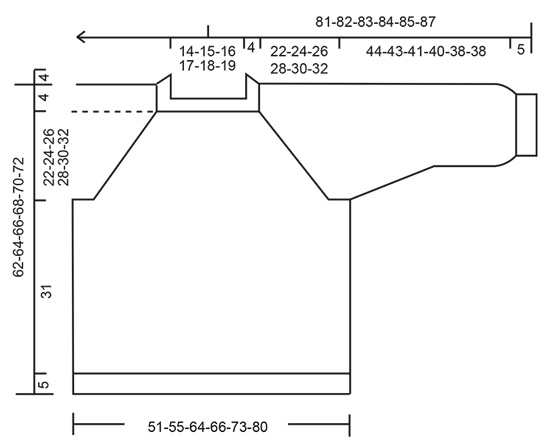 |
|
Have you finished this pattern?Tag your pictures with #dropspattern #lagoonsweater or submit them to the #dropsfan gallery. Do you need help with this pattern?You'll find 18 tutorial videos, a Comments/Questions area and more by visiting the pattern on garnstudio.com. © 1982-2025 DROPS Design A/S. We reserve all rights. This document, including all its sub-sections, has copyrights. Read more about what you can do with our patterns at the bottom of each pattern on our site. |
|







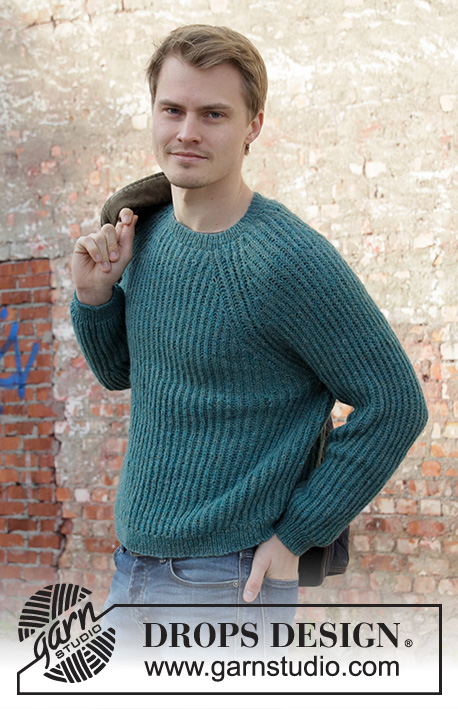
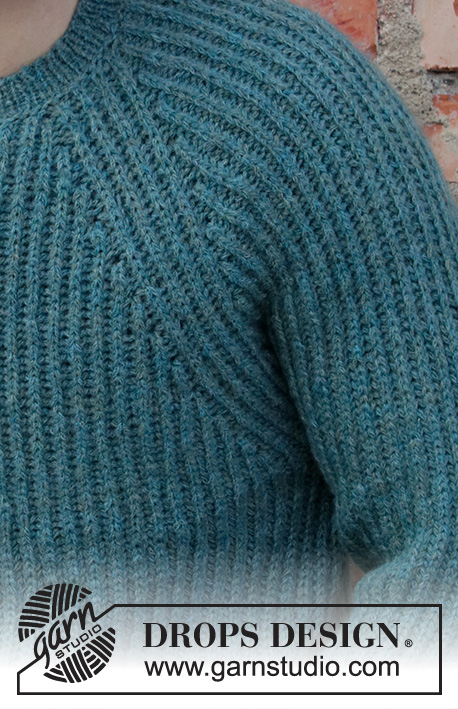

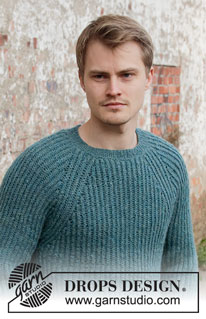
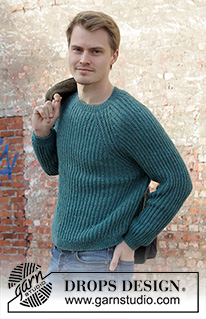
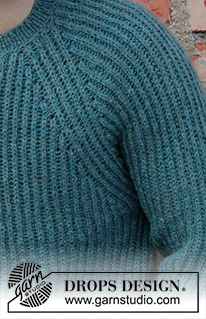






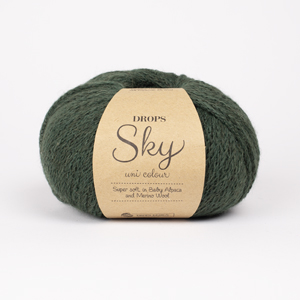
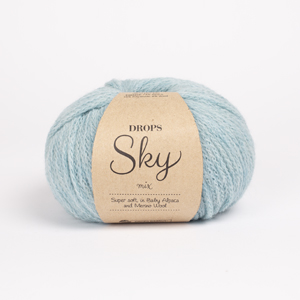

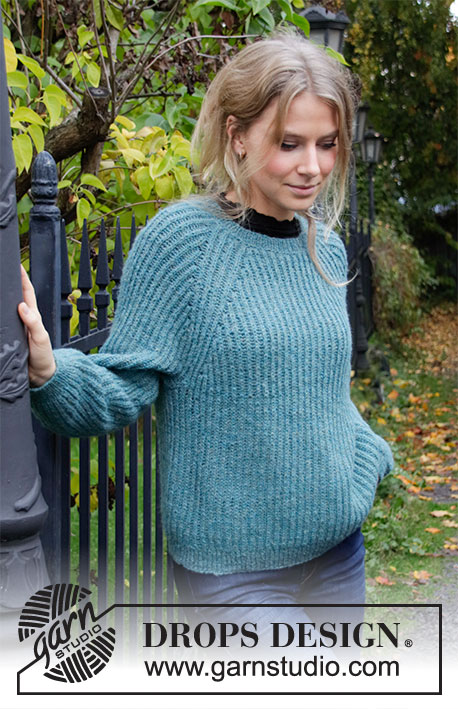

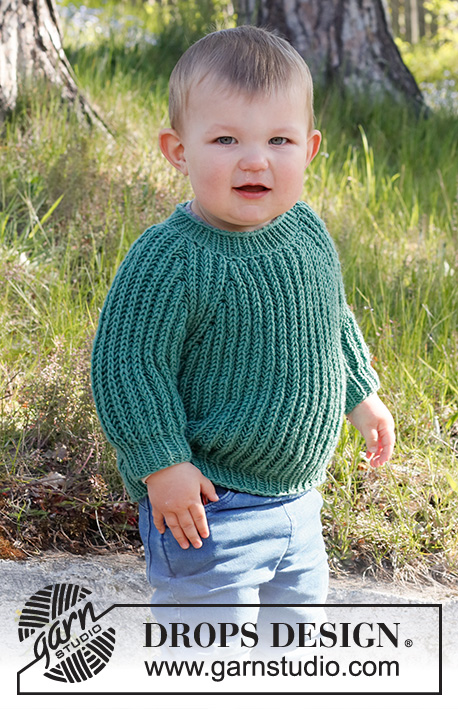


















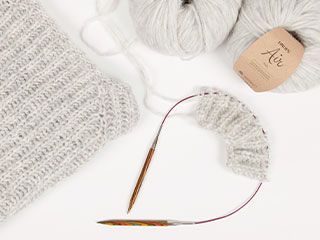















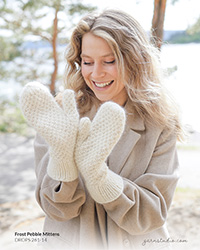

Post a comment to pattern DROPS 208-9
We would love to hear what you have to say about this pattern!
If you want to leave a question, please make sure you select the correct category in the form below, to speed up the answering process. Required fields are marked *.